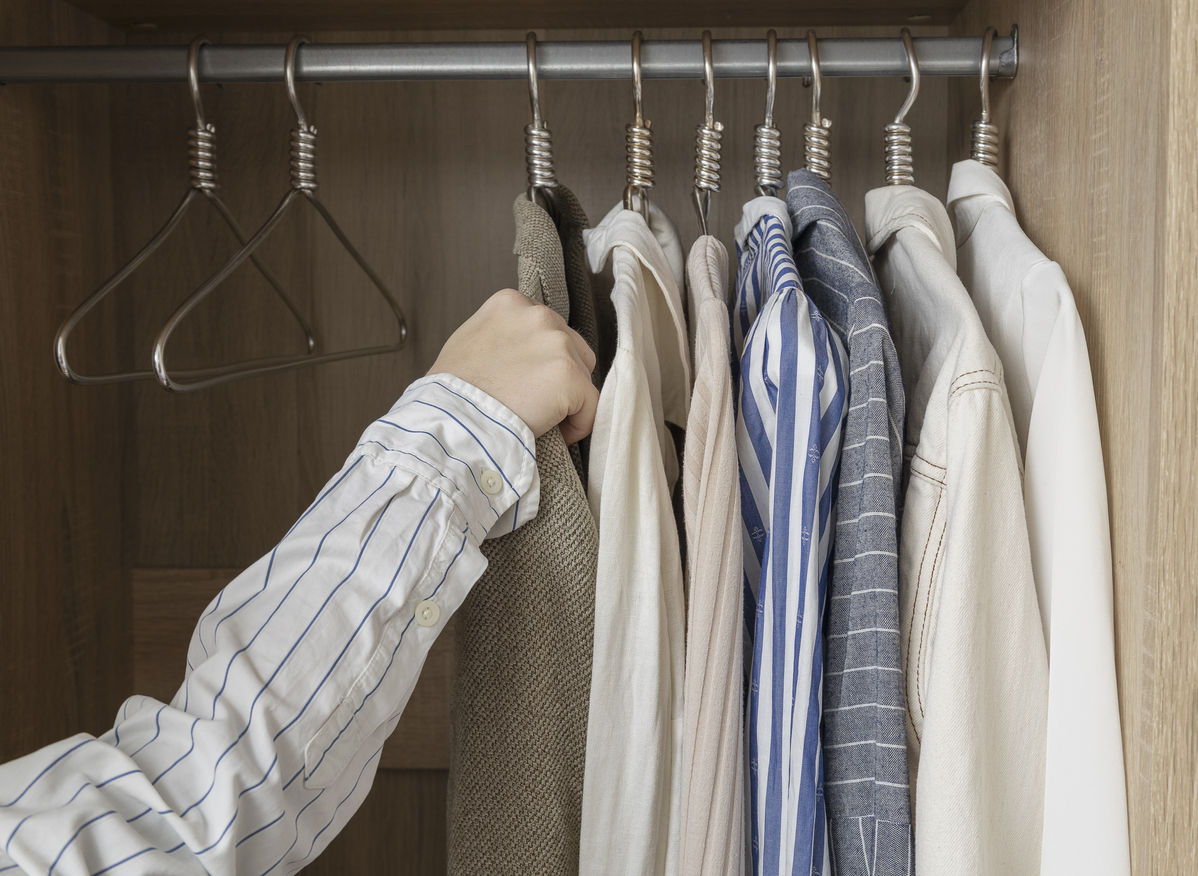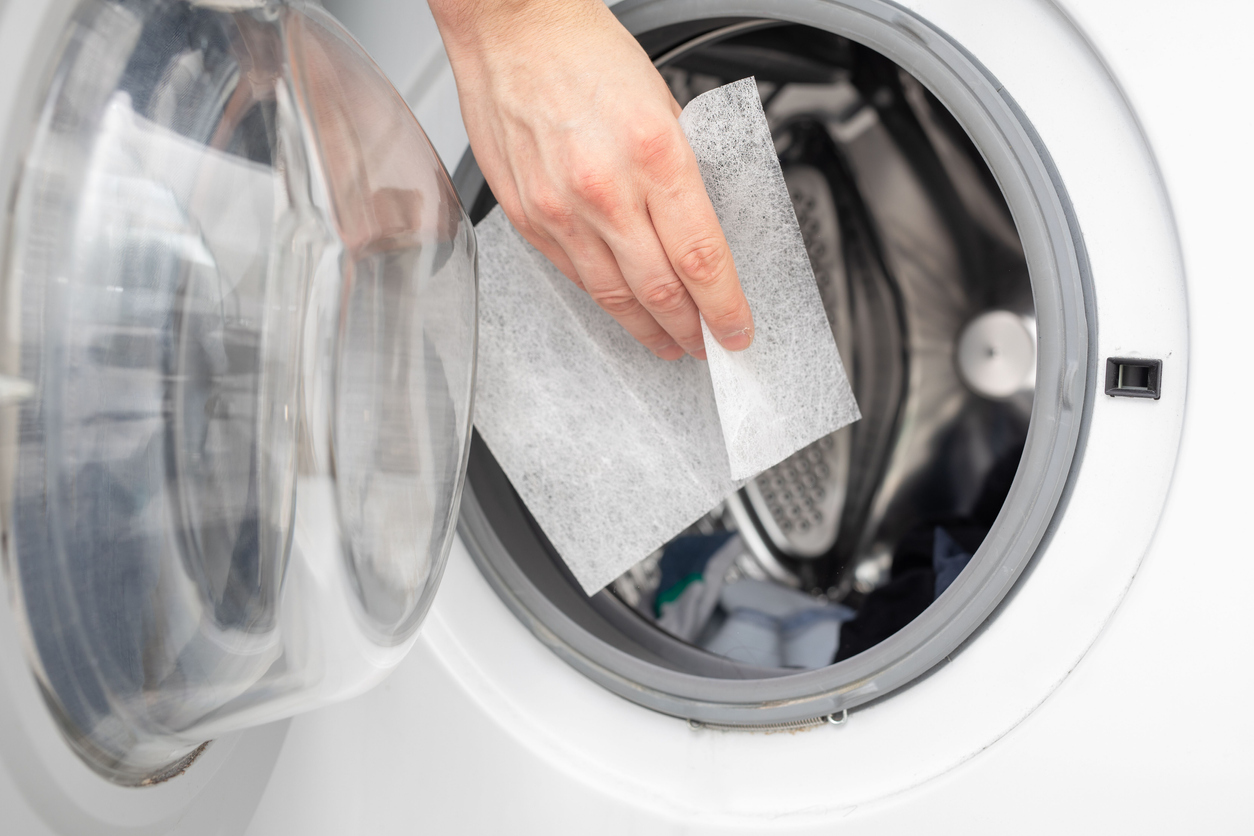We may earn revenue from the products available on this page and participate in affiliate programs. Learn More ›
It’s unpleasant when clothing items cling to one another, and it’s even worse when a skirt, shirt, or pants refuse to lay correctly and ride up when wearing it. This annoying phenomenon is known as static cling. As the Museum of Science and Industry, Chicago, explains, static cling is the result of different materials transferring electrons. If one clothing item gives up some electrons, it will have a positive charge. However, the other item that gained electrons now has a negative charge. The two items are now attracted to one another, just like magnets with opposite charges.
Static electricity can form in different ways and in different locations—think about rubbing your hair with a balloon or taking clothes out of the dryer. As clothing items in the dryer rub against one another, they begin to transfer electrons (particularly as they are becoming dry, and especially when they are over-dried). This transfer of electrons is more likely to happen during the winter months when there is low humidity, as moisture in the air and on the surfaces of the clothing items can help limit electrons moving between different garments.
Fortunately, static cling isn’t dangerous, but it definitely isn’t something many of us want to deal with. Read on to learn how to get rid of static cling from clothing items as well as some methods to prevent these static charges from building up in the first place.
How to Get Rid of Static Cling
Static cling doesn’t have to ruin your day—or your outfit. The tips below will help you get rid of static so you can go back to thinking about more important things.

1. Use static spray for clothes.
An anti-static spray for clothes—such as the Sprayway Anti-Static Spray available at Amazon—can be very helpful for eliminating static cling. These sprays offer a special formula that can work to rebalance the electrical charges on different garments. The sprays work by leaving a thin coating on each garment, which prevents an electrical charge from forming.
2. Rub clothing with metal.
Metal can interrupt the electrical charge on clothes and get rid of static cling. If your clothes are sticking together with static electricity, try rubbing the flat side of a wire hanger along any areas that are clinging together.
If you don’t have any wire hangers, you can also use a piece of aluminum foil to remove static from clothes. This trick is easy enough that it can also help release static cling from clothing items you are wearing.
3. Dampen clothes.
Dampening clothes is a great option for getting rid of static cling naturally. As shared above, static cling is worse when humidity levels are low, leaving the air and everything else overly dry. By lightly spritzing your clothes, you’re adding some moisture, which can help with getting rid of static cling.
Just make sure to read your fabric label before applying water. While this can be an effective solution for cotton, nylon, or polyester fabrics, it isn’t the best choice for silk or other fabrics that should not get wet.

4. Apply moisturizer to your skin.
In addition to making your garments stick to one another, static cling can also make your clothing stick to your body. This can be uncomfortable, or even embarrassing, depending on how and where the garment is clinging.
One reason your clothing items may be clinging to your skin also relates to a lack of moisture. Applying some lotion or moisturizer to your skin can help. The moisturizer will form a barrier over your skin and, as the garment absorbs some of the lotion, it will also help discharge the electricity.
5. Spray clothes with hair spray
Believe it or not, hair spray can also help remove static charges from your clothes. Simply spray a small amount on the inside of the affected garment, and it should release the electrical charges and prevent the item from clinging to other clothes or your body. This method may not be as long-lasting as some other alternatives, but it is certainly good in a pinch. Just be sure to read the fabric’s care directions before trying hair spray.
RELATED: 19 Laundry Mistakes You’re Probably Making
How to Prevent Static Cling
Rather than waiting until static cling is already an issue, there are also a few things you can do to prevent it in the first place. Because static cling on clothing forms in the dryer when electrons transfer between garments, these suggestions primarily focus on ways you can change your drying routine to solve the problem of static.

1. Use dryer sheets.
Dryer sheets can do some pretty surprising things—including dusting, keeping scissors from getting dull, polishing chrome, and reducing static cling. Each dryer sheet has a light coating of fabric softener, which carries a positive charge. This positive charge helps to counteract the negatively-charged electrons that can transfer between garments and result in static cling.
2. Avoid over-drying fabrics.
You can reduce static from dryer clothes by making sure you don’t over-dry your garments. As mentioned earlier, static cling is caused by electrons transferring between your clothing items as they rub against each other in the dryer. More electrons will transfer when the clothes in the dryer are already dry but keep tumbling about and rubbing over each other. So, if you turn off the dryer and remove your items once they are dry (or even just a touch damp), you can reduce the potential for static cling.
Another tip that can help minimize static electricity is to shake out each garment as you take it out of the dryer. Doing so can help keep the static from getting set in and causing even more annoying problems when you wear the items.

3. Line-dry clothing.
If you want anti-static clothing, consider completely eliminating the dryer from the equation. Hang-drying clothing will keep them from rubbing against each other in the dryer, preventing static cling from forming. Invest in a clothesline or drying rack so you can air dry your clothes in your laundry room, or even outside if the weather permits.
4. Toss in dryer balls.
Adding wool dryer balls, like this highly rated option available at Amazon—a favorite in our researched guide to the best dryer balls, to each cycle can also be an effective way to reduce static cling. The wool material is absorbent, so it will take in some moisture from the wet clothes during the beginning of the cycle. As the cycle nears its end, it slowly releases some of this moisture back into the items.
These higher moisture levels can counteract the negatively charged electrons and keep static electricity from building up. However, it’s still important to avoid over-drying each load for the best results.
RELATED: Become a Laundry Ninja With This Guide to Washing Machine Settings
5. Increase home humidity levels.
When the air is dry and humidity levels are low, static electricity is more likely to form. Conversely, if there are higher levels of moisture in the air, the electrical charges won’t be able to develop as strongly.
Running a cool mist humidifier in your home to increase humidity levels—particularly in the winter when it’s very dry—can help. Aim to keep your indoor humidity level between 30 and 40 percent during the colder months to minimize static charges. We’d recommend the Levoit Cool Mist Humidifier.


